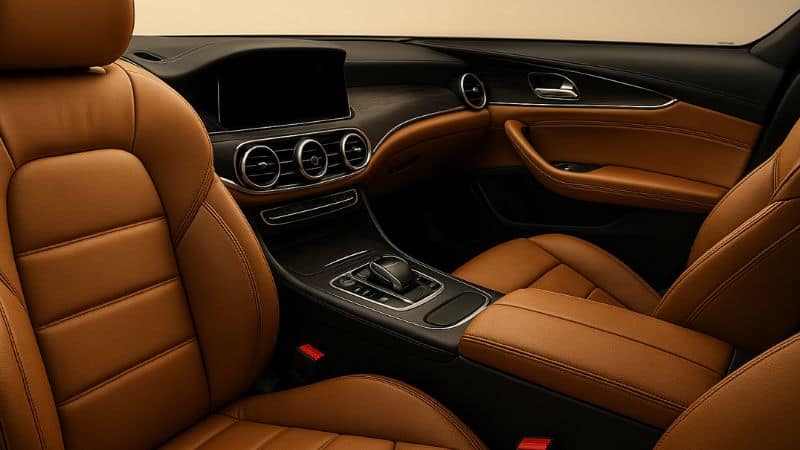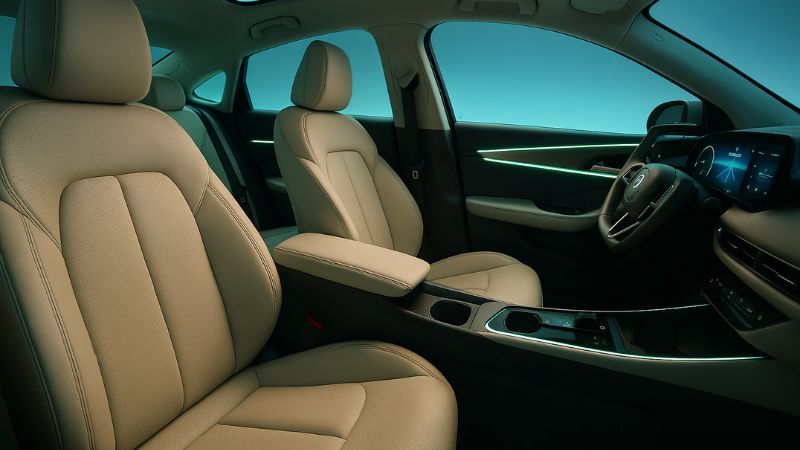Leather upholstery in cars refers to the use of genuine or synthetic leather to cover seats, door panels, and other interior trim elements. It transforms an ordinary cabin into a space that feels elegant, refined, and comfortable.
For decades, leather has symbolized sophistication and exclusivity in the automotive world. Its texture, scent, and finish instantly elevate a car’s appeal, making it synonymous with luxury and craftsmanship.
Today, leather upholstery isn’t limited to premium models. From compact sedans to restored classics, more car owners are embracing leather interiors for their durability, easy maintenance, and timeless style that blends comfort with prestige.
Recommended Read: How to Upholster a Leather Chair Step-by-Step – Review & Guide

What Is Leather Upholstery in Cars?
Leather upholstery refers to the use of genuine or synthetic leather to cover a vehicle’s seats, interior panels, and trims. It gives a polished, premium look while offering a tactile experience that’s soft, smooth, and durable—something fabric simply can’t replicate.
Why It’s Considered a Mark of Luxury and Quality
From luxury sedans to sports cars, leather interiors have long been linked to status and craftsmanship. The texture, scent, and stitching detail convey refinement, reflecting both comfort and class. Leather also enhances resale value, making it a sought-after feature among car buyers.
Growing Popularity in Modern and Vintage Vehicles
In recent years, leather upholstery has become more accessible, extending beyond high-end models. Car enthusiasts and restorers now prefer leather not just for aesthetics but for its long-lasting performance. Whether in a brand-new SUV or a refurbished classic, leather adds timeless appeal that bridges tradition and modern comfort.
Types of Leather Used in Car Upholstery
Car interiors can feature various kinds of leather, each offering a unique balance of texture, durability, and price. Here’s a quick look at the most common types:
- Genuine Leather
This includes full-grain, top-grain, corrected-grain, and aniline leathers. Full-grain leather retains the natural grain and is prized for its strength and authentic look. Top-grain leather is slightly sanded for a smoother, more uniform finish. Corrected-grain leather undergoes more processing for consistency, while aniline leather offers a rich, natural texture with minimal coating. - Synthetic Leather (Faux or Vegan Leather)
Made from polyurethane (PU) or polyvinyl chloride (PVC), synthetic leather mimics real leather’s look and feel but at a lower cost. It’s easy to clean, resistant to stains, and available in many colors—ideal for budget-conscious or eco-minded car owners. - Leather-Trimmed Upholstery
A blend of real and synthetic materials, this option uses genuine leather only on high-contact areas like seat centers and headrests. It delivers the premium feel of leather without the full cost.
Each type has its own appeal—real leather for luxury, faux leather for practicality, and hybrid upholstery for a smart middle ground.
Benefits of Leather Upholstery for Cars
Leather upholstery isn’t just about style—it offers a range of practical and long-term advantages that make it a smart investment for car owners.
- Premium Aesthetic and Resale Value
Leather instantly elevates a car’s interior, giving it a sleek, luxurious look. Its high-end appeal also boosts resale value, as used-car buyers often view leather seats as a mark of quality and care. - Comfort and Durability
Unlike fabric, leather adjusts to body temperature and becomes more comfortable over time. It’s naturally durable, resisting wear, fading, and stretching when properly maintained. - Easy Cleaning and Maintenance
Leather doesn’t trap dust or odors like cloth. Spills and stains can be wiped off effortlessly, making it ideal for families and pet owners. - Timeless Appeal
Leather’s classic texture and elegance never go out of style. Whether it’s a modern sedan or a restored vintage model, leather interiors always exude sophistication and charm.
Drawbacks to Consider
While leather upholstery adds undeniable elegance, it also comes with a few practical challenges worth noting.
- Higher Cost
Genuine leather seats can significantly increase a car’s price tag. The material itself is expensive, and professional installation adds to the cost—making it less budget-friendly than fabric or synthetic options. - Temperature Sensitivity
Leather absorbs heat and cold quickly. In summer, it can get uncomfortably hot; in winter, it feels chilly until the car warms up. Ventilated or heated seats help, but those features often cost extra. - Maintenance Requirements
To keep leather supple and crack-free, regular conditioning and cleaning are essential. Neglecting care can lead to fading, dryness, and surface cracking over time. - Slippery Texture
Compared to fabric, leather can feel slick, which may slightly affect seating comfort—especially during sharp turns or spirited driving.
Choosing the Right Leather for Your Car
Selecting the ideal leather for your car interior depends on your lifestyle, budget, and aesthetic preferences. Here’s how to make the right choice:
- Match Leather Type to Your Needs
If you prioritize luxury and authenticity, full-grain or top-grain leather offers unmatched richness and comfort. For those seeking affordability and easy upkeep, PU or PVC synthetic leather provides a great balance of look and practicality. - Consider Color and Finish
Light colors like beige or cream create an airy, upscale vibe but may show stains more easily. Darker tones like black, brown, or maroon hide wear better and feel timeless. Matte finishes give a modern touch, while glossy ones highlight opulence. - Check for Quality Indicators
Genuine leather has a natural grain, mild scent, and soft yet firm texture. Faux leather often feels smoother and more uniform. If possible, test samples—real leather warms up quickly to touch, while synthetic versions tend to stay cooler. - Think Long-Term
Investing in higher-quality leather may cost more upfront but lasts longer and enhances resale value. Choosing wisely ensures your car remains stylish, comfortable, and durable for years.
Installation: DIY vs. Professional Upholstery
Replacing or upgrading car upholstery requires precision, patience, and the right tools. Whether you choose a do-it-yourself (DIY) route or hire a professional depends on your skills, budget, and the desired finish.
- DIY Installation
DIY kits are available for enthusiasts who enjoy hands-on projects. They include pre-cut leather pieces and adhesives designed for specific car models. While this option is cost-effective, it demands accuracy—poor fitting or loose stitching can affect the seat’s appearance and comfort. - Professional Installation
Hiring a professional upholsterer ensures expert fitting, uniform stitching, and perfect alignment. Professionals can also repair seat padding, integrate heating or ventilation systems, and match factory standards. The higher cost pays off in flawless results and long-term durability. - When to Choose Which
If your car needs minor touch-ups or you’re experienced with interior work, DIY might suffice. But for full replacements, premium vehicles, or custom designs, professional installation guarantees superior craftsmanship and value.
Caring for Leather Car Upholstery
Proper care keeps leather upholstery soft, vibrant, and long-lasting. Without maintenance, even premium leather can crack, fade, or lose its sheen. Here’s how to protect your investment.
- Regular Cleaning
Wipe seats weekly with a soft microfiber cloth to remove dust and grime. For deeper cleaning, use a mild leather cleaner—never household detergents—as harsh chemicals strip natural oils and cause dryness. - Conditioning
Apply a quality leather conditioner every two to three months. Conditioning replenishes oils, keeps leather supple, and prevents cracks or stiffness caused by heat or UV exposure. - Protection from Sun and Moisture
Whenever possible, park in shaded areas or use sunshades. UV rays can fade leather color over time. Also, avoid leaving windows open during rain—moisture weakens leather fibers. - Quick Stain Management
Clean spills immediately with a damp cloth. For oily stains, sprinkle a little cornstarch, let it absorb, then gently brush it away. Prompt action prevents permanent discoloration.
Consistent cleaning and conditioning not only preserve beauty but also ensure your leather seats age gracefully—gaining character rather than wear.
Cost Breakdown
The cost of leather upholstery varies widely depending on material type, vehicle model, and whether the work is done professionally or through a DIY kit. Here’s what to expect before making the upgrade.
- Material Costs
Genuine leather is the priciest option, ranging from $1,500 to $3,000 for a full interior in most cars. Premium hides like full-grain or aniline leather can exceed that. Synthetic alternatives such as PU or PVC leather usually cost $800 to $1,500, offering a similar look at a lower price point. - Labor and Installation
Professional installation adds $500 to $2,000, depending on the vehicle’s complexity and custom detailing (like embroidery, perforation, or dual-tone stitching). DIY kits are cheaper but risk inconsistent results if not installed carefully. - Long-Term Value
Though the initial expense is higher, leather upholstery enhances your car’s resale value and lifespan. With proper maintenance, it can last over a decade—making it a durable, cost-effective choice over time.
In short, leather upholstery is an investment: you pay more upfront, but gain long-term comfort, elegance, and value retention.
Leather Upholstery Trends (2025 and Beyond)
The world of automotive interiors is evolving, and leather upholstery continues to adapt—combining tradition with technology and sustainability.
Recommended Read: Key Innovations Meant for Sustainable Leather Industry
- Sustainable and Eco-Friendly Leather
Carmakers are increasingly turning to eco-conscious materials like plant-based or recycled leather. These alternatives reduce environmental impact while maintaining the luxurious feel of genuine leather. Brands now offer vegan leather made from sources like cactus, pineapple, or apple fibers. - Customization and Color Innovation
Drivers today want personalization. Expect to see bold hues, dual-tone combinations, and unique stitching patterns that reflect individual style. Matte, perforated, and suede finishes are trending for a modern touch. - Smart and Hybrid Interiors
Technology is merging with comfort. The latest vehicles feature temperature-regulating leather, self-cleaning coatings, and integrated heating or cooling systems—enhancing both convenience and longevity.
The trend is clear: tomorrow’s leather upholstery will be smarter, greener, and more expressive, blending timeless craftsmanship with future-ready innovation.
Wrap Up
Leather upholstery remains the gold standard for car interiors—a perfect mix of elegance, comfort, and longevity. Its natural texture, rich aroma, and premium look make every drive feel a little more refined.
Beyond aesthetics, leather’s durability and easy maintenance justify the investment. With proper care, it can outlast fabric interiors while adding value to your vehicle.
As innovation reshapes automotive design, leather continues to evolve—becoming more sustainable, customizable, and technologically advanced. Whether you’re upgrading a modern SUV or restoring a vintage classic, leather upholstery ensures your car stands out with timeless luxury.



